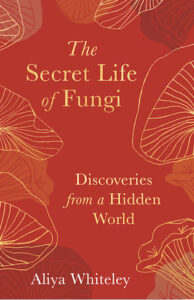I’m not quite certain what has brought widespread interest in fungi to the fore this past decade. Perhaps it has been the expansion of awareness of mycelial networks and their relationship to forests, or maybe it is related to expanding grass-roots campaigns to legalize psilocybin for medical use in the treatment of PTSD and other difficult-to-treat psychological conditions. It may even simply be that there has long been a widespread popular interest in mushrooms lying just under the surface of public discussion that has finally received the proper amount of metaphorical rainfall to cause it to fruit.
In regard to this recent fruiting, as it relates to publishing, readers have been presented with a remarkable variety of options – including fiction. I was both delighted as well as impressed by the discovery in Catherynne M. Valente‘s novel The Girl Who Fell Beneath Fairyland and Led the Revels There (my bedside book at the time of this writing) of a very well-placed and well-explained passage presenting how mycelial networks function, and how fungi themselves live and grow. And indeed, taking up Aliya Whiteley‘s recently published The Secret Life of Fungi; Discoveries from a Hidden World, a reading of the author’s dust jacket biography disclosed that she also has employed the mysterious – well, to humans, at least – ways of fungi in the plot of her own novella, The Beauty.
However, Ms. Whiteley’s aforementioned The Secret Life of Fungi is decidedly not fiction – although were one wholly unaware of the remarkable natural history of fungi one would be forgiven for thinking that parts of it might be. For to be sure, natural philosophers, naturalists, and even scientists from centuries past right up to our present day have been perplexed, confused, and amazed at so many of the discoveries made, and the myriad mysteries still yet to be solved, about this remarkable kingdom of life.
That fungi are now classified as a taxonomic kingdom all to themselves, that they are capable of launching spores with the highest amount of force generated by any known living organism, that they are responsible for assisting in the reproduction of other wholly unrelated species and genera (from wholly other kingdoms, no less) to themselves, and that they have been part of the daily life essentials of human beings dating back thousands of years are just some of the fascinating things Ms. Whiteley presents to her readers as she introduces them to the world of fungi in this delightfully conversational book.
Very well arranged so as to be a friendly and inviting introduction to the subject, with each chapter kept short and tightly focused so as not to overwhelm her readers with too much information at any one time, The Secret Life of Fungi proceeds at a brisk and lively pace that somewhat resembles that of a well-written American public broadcasting or BBC 4 program. For this reason, it is a work that could easily be read by adults and younger readers alike; indeed, in these days when so many children are taking their lessons at home rather than in a formal classroom, Ms. Whiteley’s book could easily and effectively be employed very well as part of a course on biology for secondary school students.
A significant part of what makes this such a successful book is Mr. Whiteley’s own enthusiasm about fungi. Not a mycologist or even a biologist, but a true amateur in the very best classical sense of that now unfortunately too-often abused word, she interweaves her own experiences with, curiosities about, and even at one point a recipe for cooking fungi. To read her bright, lively chapters – any of which could stand on its own as a short essay on its particular topic – is to walk with her along shaded forest floors, through underground tunnels, across farm fields, around kitchen work tables, and down museum halls as she recounts the discoveries she had made about this favorite subject of hers.
The Secret Life of Fungi is a book that I very much recommend for all seeking an introduction to the subject. I also heartily recommend it to those already familiar with the fascinating natural history of this kingdom as given the extensive metaphorical mycorrhizae of topics stretching out from its pages into the world they may be expected to find previously unknown bits of fungal lore that will enrich their existing knowledge and promote its further growth.
 Title: The Secret Life of Fungi; Discoveries From a Hidden World
Title: The Secret Life of Fungi; Discoveries From a Hidden World
Author: Aliya Whiteley
Publisher: Elliott & Thompson
Format: Hardback
Pages: 195 pp.
ISBN: 9781783965304
Published: October 22, 2020
In accordance with Federal Trade Commission 16 CFR Part 255, it is disclosed that the copy of the book read in order to produce this review was provided gratis to the reviewer by the publisher.
Nota bene: the copy of The Secret Life of Fungi I am presently reading and about which I have written in the above paragraphs refer to the original edition published by Elliott & Thompson books in the U.K. A U.S. edition of the book will be published this coming autumn under the same title by Pegasus Books.
Available from:
North American edition from Pegasus:

If you enjoyed reading this, please consider signing up for The Well-read Naturalist's newsletter. You'll receive a helpful list of recently published reviews, short essays, and notes about books in your e-mail inbox once each fortnight.
